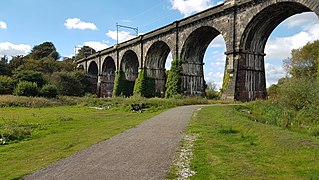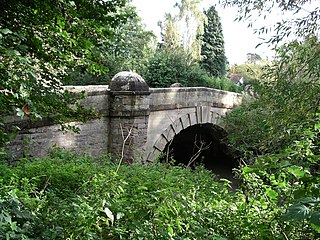The Manchester and Birmingham Railway was built between Manchester and Crewe and opened in stages from 1840. Between Crewe and Birmingham, trains were worked by the Grand Junction Railway. The M&BR was merged into the London and North Western Railway in 1846.

Rugby railway station serves the market town of Rugby in Warwickshire, England. The current station dates from 1885; two previous stations dating from 1838 and 1840 respectively, existed at locations to the west of the current one. It has been Rugby's only station, since the closure of the former Rugby Central station in 1969, on the now-abandoned Great Central Main Line route through the town. Between 1950 and 1970, the station was known as Rugby Midland before reverting to its original title. The station underwent an extensive remodelling between 2006 and 2008; new platforms were added and a new ticket office and entrance building were constructed. The original Victorian part of the station was retained in the upgrade.

Wolverton railway station serves Wolverton, a constituent town of Milton Keynes, Buckinghamshire, England. The station is on the West Coast Main Line, about 52 miles (84 km) from Euston, between Milton Keynes Central and Northampton. The station is one of the seven stations serving the Milton Keynes urban area.

Coventry railway station is the main railway station serving the city of Coventry, West Midlands, England. The station is on the Birmingham loop of the West Coast Main Line (WCML); it is also located at the centre of a junction where the lines to Nuneaton and to Leamington converge. It is situated on the southern edge of the city-centre, just outside the Coventry ring road, about 250 yards to the south of junction 6.

The Sankey Viaduct is a railway viaduct in North West England. It is a designated Grade I listed building and has been described as being "the earliest major railway viaduct in the world".

The River Sherbourne is a river that flows under the centre of the city of Coventry, in the West Midlands, in England.

The Rugby to Leamington Line was a railway line running from Rugby to Leamington Spa. It was a 15-mile (24 km) branch line built by the London and North Western Railway (LNWR) and opened in 1851. The branch connected Leamington with the mainline from London to Birmingham which had been opened in 1838 by the LNWR's predecessor, the London and Birmingham Railway (L&BR).

The River Irwell Railway Bridge was built for the Liverpool & Manchester Railway (L&MR), the world's first passenger railway which used only steam locomotives and operated as a scheduled service, near Water Street in Manchester, England. The stone railway bridge, built in 1830 by George Stephenson, was part of Liverpool Road railway station. The bridge was designated a Grade I listed building on 20 June 1988.

Charterhouse, Coventry is a grade I listed building on London Road, Coventry, in the West Midlands of England.

The Midland Counties Railway viaduct is a disused railway viaduct at Rugby, Warwickshire, which crosses over both the A426 Rugby to Leicester road, and the River Avon to the north of Rugby town centre.

Brandon Viaduct is a railway viaduct crossing the River Avon between the villages of Brandon and Wolston in Warwickshire. It carries the Birmingham Loop line and is roughly half way between Rugby and Coventry. The bridge was built in around 1835 for the London and Birmingham Railway and is now a grade II listed building.

The Sowe Viaduct is a railway bridge on the Birmingham Loop line crossing the River Sowe at the south-eastern edge of Coventry in central England. Built in 1838, it is a Grade II listed building.

Mile Lane Bridge is a road-over-rail bridge in Coventry, central England. It is possibly the first use of a flying arch over a railway cutting and is a Grade II listed building.

Wolverton Viaduct is a railway bridge carrying the West Coast Main Line over the River Great Ouse to the north of Wolverton, part of the City of Milton Keynes, in south-eastern England. Built in 1837 for the London and Birmingham Railway under the supervision of Robert Stephenson, it is one of the largest and most notable structures on the route and is a grade II listed building.

Spon End Viaduct is a railway bridge which spans the River Sherbourne in Spon End, just west of the city centre of Coventry in central England.

The Blisworth Arch is a railway bridge in Blisworth, Northamptonshire, in eastern England. It was designed by Robert Stephenson for the London and Birmingham Railway and completed in 1837. It is a grade II listed building and a significant local landmark.

Hampton in Arden packhorse bridge crosses the River Blythe near Hampton in Arden in the West Midlands of England, between Birmingham and Coventry. Dating from the 15th century, it is the only bridge of its kind in the area now covered by the West Midlands, and is a grade II* listed building and a scheduled monument.

The Brent Viaduct is a railway bridge carrying the West Coast Main Line over the valley of the River Brent just south of Stonebridge Park station in north-west London, England. Originally built in 1838 for the London and Birmingham Railway, it is now a Grade II listed building.

Bushey Arches Viaduct is a railway bridge on the West Coast Main Line immediately north of Bushey railway station, between Bushey and Watford, in Hertfordshire, Eastern England, just north-west of London.

The Colne Viaduct, also known as Five Arches Viaduct, carries the West Coast Main Line railway over the River Colne near Watford in Hertfordshire, Eastern England, just north-west of London. It was built in 1837 for the London and Birmingham Railway by Robert Stephenson.




















